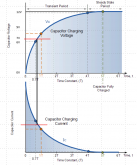Astronom, I'm afraid we are getting away from the question of whether to leave the resistor inline after the caps have charged. I believe FilterGuy is correct but for a different reason altogether.
Indeed, then I would like to try to explain my point further, as we did not understand the same stuff from the posts
71 and
78.
While it is true that two parallel wires are commonly used to increase the equivalent gauge that is not relevant here as we are discussing a circuit with one leg as a low resistance wire and the other leg as a resistor. True but not relevant.
Whichever the resistance of 2 legs of a circuit (even if they are very different as in this case), the total equivalent resistance of the circuit comprising the two legs in parallel will be
lower than each resistance of both legs. As a thought experiment, you can consider the large diameter main wire like many (call that N) small diameter wires that are in parallel. You could chose this "small" diameter such as the N imaginary small wires have a resistance equal to the one of the resistor we add in parallel to them. You get then the equivalent of a large wire composed of N+1 small wires. Then the total circuit behaves the same as if there was just one large diameter wire, very slightly larger than the wire that you put in parallel to the resistor in the first place. And I guess we agree that a larger wire has lower Joule effect heat dissipation.
My original concern was that leaving a resistor in a circuit after it is no longer needed is a waste of energy as some portion of whatever current flows through it will be converted to heat. This is also true but not relevant.
This is a point I disagree with in this case. You would be right if you write "leaving a resistor
in series", because then indeed the total equivalent resistance of the circuit would be the main wire + the resistor, therefore higher Joule effect power will be dissipated. Here we leave a resistor
in parallel to the main circuit, thereby decreasing the equivalent resistance and therefore decreasing Joule effect power.
The relevant point FilterGuy made is that very little current will flow through the circuit leg with the resistor in it. This is likely to be so insignificant of an amount that you can basically ignore that leg of the parallel circuit. This I believe to be true and relevant.
That's not exactly the point he made but I may be wrong (in which case please correct me
@FilterGuy). It's true that some power will be dissipated through the resistor if it's left in parallel to the main wire. But because the current that is going through the resistor leg doesn't go through the main wire leg, the power dissipation in the main wire will in turn decrease. This decrease will more than offset the increase of dissipated power in the resistor. In part because Joule effect scales with square of intensity, therefore a small variation of intensity in for a high initial intensity has a larger effect on Joule power dissipation than the same variation for low initial intensity.
Yes the total variation of dissipated power will be insignificant, but it will be a
decrease nonetheless, not an increase as it seems you are advocating.
I have ordered a resistor which should get here in a couple days. At that time I will charge the caps and measure any current after that to confirm the hypothesis but I expect any measurable current in the resistor side of the circuit to be insignificant. I will report back either way.
I'm not sure it's the right experiment to do. There will be for sure some current in the resistor, whether you can measure it or not. But if you want to know the full power dissipation of the circuit you also have to measure the current through the main wire, which will be a bit lower than for the same main wire without the resistor in parallel (again you might not be able to measure the difference). So even if you find out that the resistor dissipates let's say 1W, actually you should also be able to measure that the main wire dissipates a bit more than 1W less than before. But this will be quite hard to measure as the current difference will amount for a super tiny fraction of the full current.











